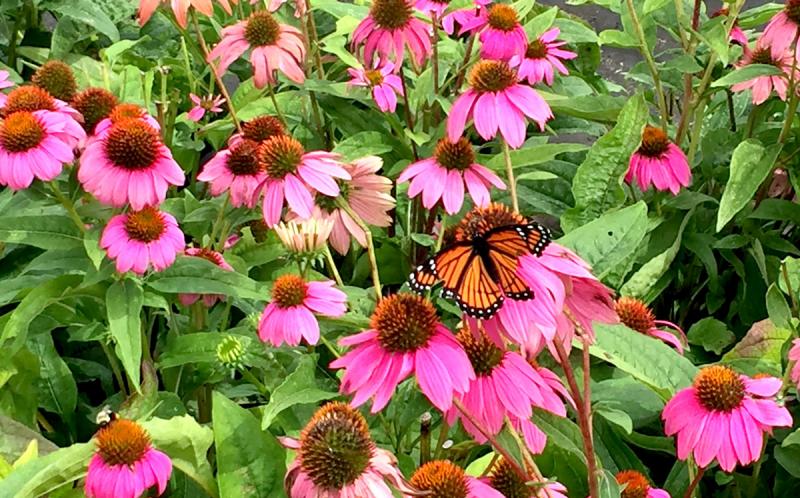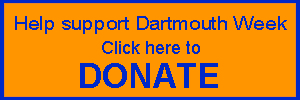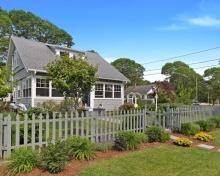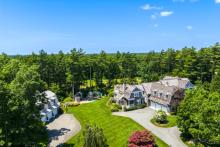13 fun facts about plant pollinators
As guest speaker for the Dartmouth Natural Resources Trust's 46th annual meeting on May 17, Dr. Elizabeth Farnsworth took an hour to explain how pollination works, who the pollinating species are, and the future of plants.
Farnsworth is the senior research ecologist at New England Wildflower Society. She's also responsible for the completion of more than one-hundred conservation and research plans for rare plants, and the building and promoting of the web tool Go Botany.
Here are the top 13 facts from Farnsworth's lecture.
1. Bees make your strawberries last longer.
A recent study has shown that bee pollination is better than hand or wind pollination because bees can be more thorough, said Farnsworth. When a plant is completely fertilized, it exudes hormones that improve quality and give the fruit a longer shelf-life, said Farnsworth.
2. Bees aren't the only pollinators.
Pollinators include hymenoptera (bees, wasps), flies, moths and butterflies, beatles, mosquitos, wind, water, birds, and even some shrimp. These forces help disperse pollen and fertilize plants so they reproduce.
3. Flies are the early risers.
"Flies are among the first to emerge in early spring, especially in the alpine zone," said Farnsworth. That means they are among the first to start pollinating, way ahead of bees.
4. Evolution has a lot to do with it.
Farnsworth explained that some species of plants and insects have evolved together. For example, the Madagascar orchid has a nectar spur that stretches about one foot deep. To reach the nectar, the Sphinx moth developed a "tongue" that equals that length.
5. Body odor isn't all that bad.
The bog orchid, which is native to the northeast, gives off a scent that mimics human body odor. The scent attracts mosquitos, which in turn helps pollination.
6. Plants are faster than Nascar.
The bunchberry plant has the fasted pollen dispersal, with shoots measuring 6,700 miles per hour. The second fastest pollen dispersal comes from mulberry plants, at 740 mph.
"That throws your pollen pretty far into the air column," said Farnsworth, explaining how this aids pollination.
7. Seagrasses need pollinators too.
There is evidence that seagrasses are pollinated by marine invertebrates, including shrimp and other isopods.
However, some marine plants are designed to use water to pollinate. For example, eelgrass produces female flowers that disturb the surface tension of the water and create small vortices that lead into the plant. Male flowers simply fall into the vortices and pollinate the females, said Farnsworth.
8. You can attract hummingbirds with vining honeysuckles.
But be warned, hummingbirds can be quite aggressive. "It's almost disconcerting to watch hummingbirds go after each other," said Farnsworth.
9. Plants use sex appeal too.
Plants, such as the bee orchid, use appearance to attract pollinators. The bee orchid actually looks like a bee, which attracts the actual hymenoptera looking to mate. Similarly, some plants use color to attract pollinators. For example, when bees see yellow in a flower's pedals, the color is deeply contrasted to the coloring of the nectar spur, creating a more visible target.
In contrast, plants like the skunk cabbage omit particular smells to attract flies, while the carnivorous pitcher plant has sweet nectar on its pedals, which attracts insects to a more fatal landing.
10. Bats are pollinators, but not here.
The southern fruit bat is a strong pollinator, but in New England, bat species do not aid pollination. They're mostly nocturnal and eat insects, said Farnsworth.
11. Pollen can help you travel in time.
"Pollen lasts in the soil for thousands of years," said Farnsworth. In fact, scientists have dated pollen to 14,000 years ago, which helps them reconstruct the vegetation in that time period.
Because of this, scientists know that following the Ice Age, spruce and other tundra-related plants popped up as the glaciers receded.
"It's a wonderful window into the past of our vegetation," said Farnsworth.
12. Global Warming has not stumped the bees.
Farnsworth explained that as Global Warming has caused plants to start their cycles earlier in the season, it was feared that they would not receive help from the still-sleeping pollinators.
However, studies show that bees and such pollinators are also starting earlier in the season because of Global Warming, so the two dependents are still in sync.
13. You can help the bee population.
Farnsworth suggested planting flowers that aren't infused with pesticides to keep the bee population strong. Opt for native plant species that are locally sourced. Head to a nearby field at the end of the season and collect wildflower seeds, or visit your local garden outlet, said Farnsworth.















